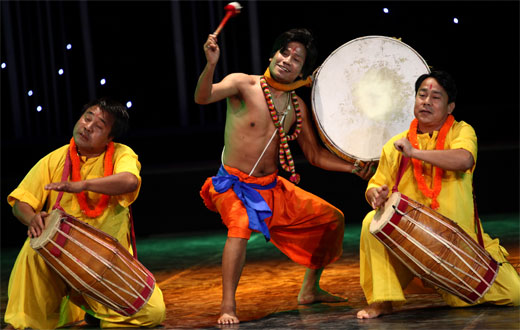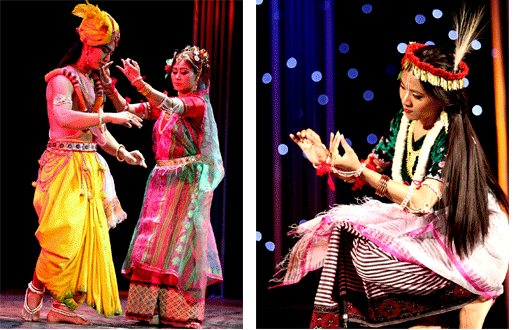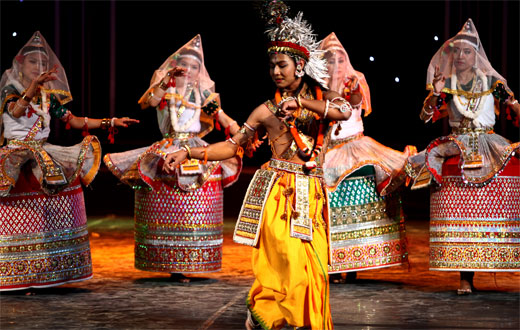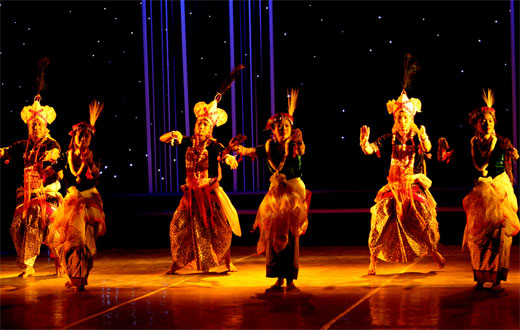In 2013 the India by the Nile festival gave Egyptians their first taste of Odissi classical dance from east India, and in 2014 it presented the Kathak tradition of the north. This year in the course of its programme (30 March-16 April), the festival hosted the Narmada Cultural Organisation from Manipur.
Performing in Cairo, Alexandria and Ismailia, the ten-member troupe walked the audience through a variety of classical and folk dances from the north-east, a unique and proud part of the country that shares aspects of India at large but also displays Mongolian influences in its rites, culture and even its people’s features.
Separated from the rest of the country by a narrow strip and suffering the results of decades-long conflicts, including ethnic divisions, Manipuri history is filled with bitterness, alienation and sometimes even hostility towards India’s central government.
Yet Mother Nature been particularly generous with the Jewel of India, a name given to the region by Jawaharlal (Pandit) Nehru. The picturesque Himalayan valleys are interspersed by brisk streams and fields of Siroy Lily (the state emblem), immaculate lakes with floating islands known as phumdis and captivating fauna that features a few hundred unique species.
Manipur is the land of Ras Leela, the region’s most important classical dance, linked to the devotional themes and the love of Krishna. No wonder Ras Leela was included in Narmada’s performance in Egypt. Among other classical and folk, the troupe also performed the iconic Pung Cholom, in which the musicians dance with their pung drums in their hands.

Manipuri dancers in Cairo (Photo: Mona Abdel Karim)
Odissi and Kathak rely on similar visual combinations, but the Manipuri troupe brought greater variety to this show with a range of rhythms, costumes, facial expressions, music and movement reflecting the wealth of their country. Each was unique and captivating.
Although many of the performers have had international experience, this was the Narmada Cultural Organisation’s first performance outside India. Certainly Khumanthem Narmada Devi, the organisation’s founder, dynamo and dance instructor has travelled; audiences in Malaysia, Singapore, Australia, Oman, UAE, are no strangers to her. Narmada is also one of the panel members of the Indian Council for Cultural Relations (ICCR), an entity that fosters links between Indian troupes and the world.
“There are many panel members at ICCR, and each gets an opportunity to tour for two years. This is my time to represent Manipur’s culture with my organisation,” Narmada explains. ICCR made Egypt the last stop on the troupe’s tour, which began in the last week of March and first took the ten artists to Cyprus, Lebanon and Jordan. With heavy luggage filled with costumes, travel is no mean feat.
Based in Delhi, Narmada’s organisation welcomes students from many other states. Some travel all the way from Manipur for summer training. Since the nature of dance is linked to other artistic elements, in many programmes the organisation incorporates musicians and martial arts performers (the latter for the stick dance).
“Part of the beauty of the Manipur tradition is the active support and cooperation that one organisation extends to another. Though the troupes and schools specialise in different components of our culture, the inner line of Manipuri performing arts is what joins us together. It is natural that we always share our experiences, support one another, cooperate,” Narmada explains in her particularly warm voice, which speaks of her passion for dance.

Manipuri dancers in Cairo (Photo: Mona Abdel Karim)
Born to a singer mother and an officer father who was supportive of his wife and children being performers, Narmada — who has over 35 years of experience behind her — was 11 when she began studying dance.
“It takes up to five or six years of training, which involves understanding the codification of the dance form, memorisation of the sequences, before a dancer is ready to step on the stage,” she explains.
Manju Elangbam, one of the dancers, explains that the artist matures while performing as the experience adds to the skill and deepens the understanding. “Apart from the regular training, with time you find out that the technique itself becomes a part of you and begins reflecting the dancer’s soul,” he says, adding that not everyone can become a good Manipuri dancer.
“The skills require two core components: flexibility and an ability to remain natural. Those qualities are linked to the nature we are surrounded with, and the scenic beauty that influences the music, dance and even songs. Of course having a sense of rhythm and a musical ear is compulsory,” Elangbam giggles as if to say that the last point is too evident to mention.
Nor is the dance a bed of roses. “Of course not everyone manages to make a living dancing,” Elangbam explains, quickly adding, “in fact, life is hard for artists all around the world, not in Manipur only.”
In this context both Elangbam and Narmada can count themselves among the very fortunate. Narmada invested her entire life in dance and she makes additional income renting the costumes. Elangbam is pursuing his PhD in dance, and refuses to see his life outside the profession; he plans to start teaching soon, as a lecturer at a dance institute or at Manipur University.

Manipuri dancers in Cairo (Photo: Mona Abdel Karim)
Another young dancer named Akham Kanaka Devi joined our conversation. In a timid voice she expressed her passions for the arts.
“Though I am currently enrolled in a master’s programme in philosophy I hope to change my thesis to research that would combine philosophy with folkloric arts. For the time being dance is my hobby and I hope my research will open further doors to taking arts in a professional manner,” she said, pointing to several exams that await her in India two weeks after return.
“Academic studies help a lot in capturing the real essence of art and dance in particular,” Elangbam explained. “It is also the whole process of widening one’s culture that adds a lot of values to the performer and shapes his interpretation of different dances.”
Troubled internally, Manipur remains the hub of a unique culture, and this is why Elangbam has hope for the region’s future.
“As Manipuris, we are different from the rest of Indian culture, we are in large part nurtured by the southern Asian forms, something you can notice in our movements and facial expressions. Until very recently it was not easy for us to go past our region’s borders. Fortunately this situation is slowly changing. Two or three years ago the government created more vibrant links with Manipur, inviting tourism as well as helping Manipuris to move out.”
Elangbam stressed that this opening of channel invited a variety of interesting elements into Manipur too, fuelling the performing arts with new values.
“The interaction with the rest of India as well as the rest of the world brings many interesting elements to our own culture. Today, a younger generation of dancers are probing different forms and creating new fusions. This is a very interesting stage in the dance’s development.”

Manipuri dancers in Cairo (Photo: Mona Abdel Karim)
This article was originally published in Al Ahram Weekly
Short link: